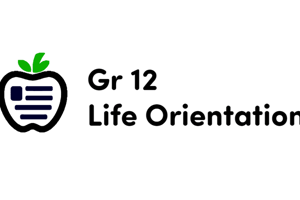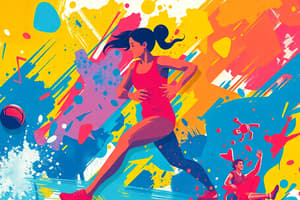Podcast
Questions and Answers
What is the primary goal of Physical Education?
What is the primary goal of Physical Education?
- To improve muscle strength exclusively.
- To teach sportsmanship without regarding fitness.
- To focus solely on health-related fitness components.
- To promote overall fitness including various dimensions. (correct)
Which function of Physical Education emphasizes the development of personality traits?
Which function of Physical Education emphasizes the development of personality traits?
- Integrative Function (correct)
- Social Function
- Cognitive Function
- Biologic Function
Which component is NOT part of health-related fitness?
Which component is NOT part of health-related fitness?
- Muscular strength
- Cardiovascular endurance
- Flexibility
- Reaction time (correct)
What does the legal basis for Physical Education in the Philippines primarily promote?
What does the legal basis for Physical Education in the Philippines primarily promote?
What best describes the health-related fitness component of body composition?
What best describes the health-related fitness component of body composition?
Which skills-related fitness component relates to maintaining equilibrium?
Which skills-related fitness component relates to maintaining equilibrium?
In terms of Physical Education, what does fitness contribute to?
In terms of Physical Education, what does fitness contribute to?
Which of the following best describes muscular endurance?
Which of the following best describes muscular endurance?
Which function of Physical Education focuses on the impact of physical activity on values and social behavior?
Which function of Physical Education focuses on the impact of physical activity on values and social behavior?
Which component of health-related fitness primarily assesses the heart and lungs' efficiency during prolonged activity?
Which component of health-related fitness primarily assesses the heart and lungs' efficiency during prolonged activity?
In the context of Physical Education, which aspect relates most closely to the capacity for multiple contractions without fatigue?
In the context of Physical Education, which aspect relates most closely to the capacity for multiple contractions without fatigue?
Which of the following best describes the objective of enhancing critical thinking in Physical Education?
Which of the following best describes the objective of enhancing critical thinking in Physical Education?
How does the evolution of Physical Education reflect the shift from a focus on muscle strength to broader educational goals?
How does the evolution of Physical Education reflect the shift from a focus on muscle strength to broader educational goals?
Which skills-related fitness component is most closely associated with the ability to change directions quickly?
Which skills-related fitness component is most closely associated with the ability to change directions quickly?
What is the primary legal basis promoting physical education in the Philippines as outlined in historical mandates?
What is the primary legal basis promoting physical education in the Philippines as outlined in historical mandates?
Which component of skills-related fitness involves the efficiency of using sensory inputs and physical movements together?
Which component of skills-related fitness involves the efficiency of using sensory inputs and physical movements together?
Study Notes
Definition of Physical Education
- Physical Education (PE) goes beyond physical training; it emphasizes learning through movement.
- Evolution of PE shifted from solely building muscle strength to encompassing various physical activities for educational purposes.
Goals and Objectives
- Primary goal of PE is to enhance overall fitness, which includes physical, mental, emotional, and social dimensions.
- Key objectives include developing motor skills, enhancing critical thinking, and fostering teamwork among participants.
Functions of Physical Education
- Biologic Function: Aims to improve physical growth and development throughout life stages.
- Integrative Function: Physical activities help to integrate various personality traits, promoting holistic development.
- Social Function: PE cultivates values such as teamwork, respect, and sportsmanship through participation.
Legal Bases in the Philippines
- Significant historical milestones include the introduction of physical exercise in schools.
- The 1987 Philippine Constitution mandates the promotion of sports and physical education within educational institutions.
Fitness as a Major Goal
- Fitness encompasses physical, social, emotional, and mental well-being, all contributing to a high quality of life.
- Being physically fit enables individuals to perform daily tasks efficiently, engage in leisure activities, and respond to emergencies effectively.
Components of Physical Fitness
- Health-Related Fitness: Comprises body composition, cardiovascular endurance, flexibility, muscular endurance, and strength.
- Skills-Related Fitness: Includes agility, balance, coordination, power, reaction time, and speed.
Health-Related Fitness Components
- Body Composition: Ratio of muscle, fat, and other tissues; a fit person displays a healthy body fat percentage.
- Cardiovascular Endurance: The ability of the heart and lungs to supply oxygen during prolonged physical activity.
- Flexibility: Range of motion in joints, facilitating effective and safe movement.
- Muscular Strength: Ability to exert maximum force, which can be explosive, static, or dynamic in nature.
- Muscular Endurance: Capability to perform repeated muscular contractions without fatigue over time.
Skills-Related Fitness Components
- Agility: Skill to make quick directional changes.
- Balance: Maintaining stability whether stationary or in motion.
- Coordination: Effective use of senses and body parts in unison.
- Power: Maximal force exerted in short bursts.
- Reaction Time: Speed of response to a stimulus.
- Speed: Quickness in movement execution.
Assessment Structure
- Test 1: Multiple choice (46 questions), includes BMI problem-solving (5 points each).
- Test 2: True or false (10 statements) covering Unit 1 topics.
- Test 3: Identification (17 items) regarding health-related and skills-related fitness, plus legal bases of PE in the Philippines (specific years).
- Test 4: Essay focused on Unit 1 content.
Total Points
- Test 1A: 46 points
- Test 1B: 20 points
- Test 2: 10 points
- Test 3: 17 points
- Test 4: 15 points
- Grand Total: 108 points
Definition of Physical Education
- Physical Education (PE) goes beyond physical training; it emphasizes learning through movement.
- Evolution of PE shifted from solely building muscle strength to encompassing various physical activities for educational purposes.
Goals and Objectives
- Primary goal of PE is to enhance overall fitness, which includes physical, mental, emotional, and social dimensions.
- Key objectives include developing motor skills, enhancing critical thinking, and fostering teamwork among participants.
Functions of Physical Education
- Biologic Function: Aims to improve physical growth and development throughout life stages.
- Integrative Function: Physical activities help to integrate various personality traits, promoting holistic development.
- Social Function: PE cultivates values such as teamwork, respect, and sportsmanship through participation.
Legal Bases in the Philippines
- Significant historical milestones include the introduction of physical exercise in schools.
- The 1987 Philippine Constitution mandates the promotion of sports and physical education within educational institutions.
Fitness as a Major Goal
- Fitness encompasses physical, social, emotional, and mental well-being, all contributing to a high quality of life.
- Being physically fit enables individuals to perform daily tasks efficiently, engage in leisure activities, and respond to emergencies effectively.
Components of Physical Fitness
- Health-Related Fitness: Comprises body composition, cardiovascular endurance, flexibility, muscular endurance, and strength.
- Skills-Related Fitness: Includes agility, balance, coordination, power, reaction time, and speed.
Health-Related Fitness Components
- Body Composition: Ratio of muscle, fat, and other tissues; a fit person displays a healthy body fat percentage.
- Cardiovascular Endurance: The ability of the heart and lungs to supply oxygen during prolonged physical activity.
- Flexibility: Range of motion in joints, facilitating effective and safe movement.
- Muscular Strength: Ability to exert maximum force, which can be explosive, static, or dynamic in nature.
- Muscular Endurance: Capability to perform repeated muscular contractions without fatigue over time.
Skills-Related Fitness Components
- Agility: Skill to make quick directional changes.
- Balance: Maintaining stability whether stationary or in motion.
- Coordination: Effective use of senses and body parts in unison.
- Power: Maximal force exerted in short bursts.
- Reaction Time: Speed of response to a stimulus.
- Speed: Quickness in movement execution.
Assessment Structure
- Test 1: Multiple choice (46 questions), includes BMI problem-solving (5 points each).
- Test 2: True or false (10 statements) covering Unit 1 topics.
- Test 3: Identification (17 items) regarding health-related and skills-related fitness, plus legal bases of PE in the Philippines (specific years).
- Test 4: Essay focused on Unit 1 content.
Total Points
- Test 1A: 46 points
- Test 1B: 20 points
- Test 2: 10 points
- Test 3: 17 points
- Test 4: 15 points
- Grand Total: 108 points
Studying That Suits You
Use AI to generate personalized quizzes and flashcards to suit your learning preferences.
Description
This quiz covers the fundamental concepts of Physical Education, including its definition and the evolution of its objectives. Test your knowledge on the goals of PE and understand how it promotes overall fitness across various dimensions. Dive into the importance of learning through movement and its impact on personal development.




